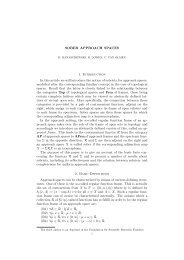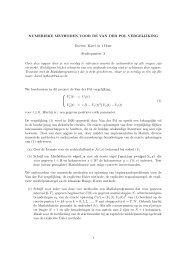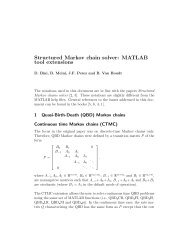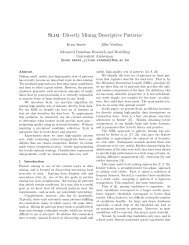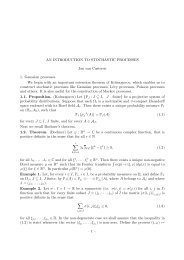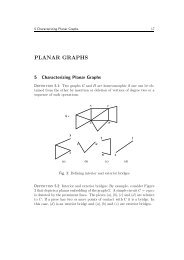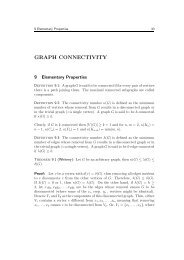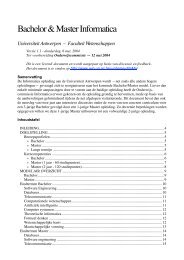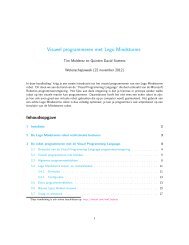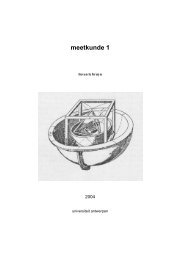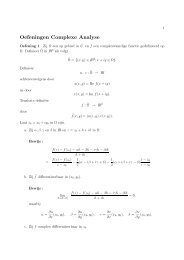Practical Rational Interpolation of Exact and Inexact Data Theory ...
Practical Rational Interpolation of Exact and Inexact Data Theory ...
Practical Rational Interpolation of Exact and Inexact Data Theory ...
Create successful ePaper yourself
Turn your PDF publications into a flip-book with our unique Google optimized e-Paper software.
2.1. Classical rational interpolation 17<br />
the barycentric form does not readily reflect the actual numerator <strong>and</strong> denominator<br />
degrees, these methods basically determine a denominator q(x)<br />
<strong>of</strong> degree ∂q ≤ m using a basis other than the Lagrange basis <strong>and</strong> restore<br />
the connection with the Lagrangian basis afterward. For example Schneider<br />
<strong>and</strong> Werner [SW86] first compute a denominator in a Newton basis with<br />
respect to Xm ⊆ Xn. For the resulting linear system <strong>of</strong> which the coefficient<br />
matrix is a divided-difference matrix (or Löwner matrix) a stable solver is<br />
proposed in [Gem96]. Only in a second phase the barycentric weights with<br />
respect to Xn are computed from these Newton coefficients using an algorithm<br />
from [Wer84]. A more direct approach is due to Berrut et al. [BM97].<br />
Using monomial basis functions, conditions for the weights are derived such<br />
that rn(x) = p(x)/q(x) satisfies ∂p ≤ ℓ <strong>and</strong> ∂q ≤ m. A very similar approach<br />
is due to Zhu et al. [ZZ02] who directly determine function values q0,... ,qn<br />
<strong>of</strong> a denominator <strong>of</strong> degree ∂q ≤ m from the same degree conditions, but<br />
now by considering the Newton representation.<br />
A slightly different, but related approach is due to Antoulas <strong>and</strong> Anderson<br />
[AA86]. They start from the following implicit form <strong>of</strong> (2.1)<br />
n<br />
i=0<br />
rn(x) − fi<br />
ui<br />
x − xi<br />
= 0 (2.4)<br />
<strong>and</strong> investigate the algebraic structure <strong>of</strong> the problem <strong>of</strong> parameterizing all<br />
interpolating rational functions <strong>of</strong> minimal complexity. Here, the complexity<br />
<strong>of</strong> a rational function rn(x) = p(x)/q(x) is understood as max{∂p,∂q}. This<br />
problem formulation is further considered in Section 5.2.<br />
Instead <strong>of</strong> the full barycentric form (2.4), Antoulas <strong>and</strong> Anderson [AA86]<br />
start from a lower complexity barycentric representation 1 [Ber00] rn ′(x) <strong>of</strong><br />
rn(x)<br />
<br />
n ′<br />
i=0<br />
rn ′(x) − fi<br />
ui<br />
x − xi<br />
= 0 (2.5)<br />
where n ′ < n. When specifying rn ′(x), it is implicitly assumed that Xn is<br />
ordered such that the first n ′ + 1 points are those appearing in (2.5). For<br />
rn ′(x) to interpolate also in the remaining points Xn \ Xn ′, a non-trivial<br />
weight vector u = (u0,... ,un ′)T must exist in the kernel <strong>of</strong> the (n − n ′ ) ×<br />
(n ′ + 1) Löwner matrix L with entries<br />
Lj,i = fj − fi<br />
xj − xi<br />
i = 0,... ,n ′ ;j = n ′ + 1,... ,n.<br />
1 This nomenclature is not used explicitly in [AA86].



